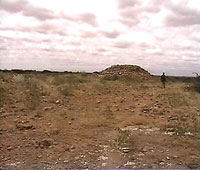Aynaba
Aynaba
| |
|---|---|
Town | |
| Coordinates:8°57′24″N46°24′43″E/ 8.95667°N 46.41194°E | |
| Country | |
| Region | Sool |
| District | Aynaba District |
| Government | |
| • Mayor | Hassan Yusuf Aden (Dhabase) |
| Area | |
| • Total | 18 km2(7 sq mi) |
| Population (2013)[1] | |
| • Total | 50,000 |
| • Rank | 10th |
| Time zone | UTC+3(EAT) |
Aynaba,also speltAinabo,AinabaorAynabo(Somali:Caynaba,Arabic:عينبة) is a major town in westernSoolregion ofSomalilandas well as the administrative seat of theAynaba District.
Overview
[edit]
Aynaba is situated on a busy tarmac road connectingSomaliland's major cities toSomaliaand is the second largest town in theSaraarregion of Somaliland afterLas Anod.[2]The town is almost at the exact center betweenBuraoandLas Anod,with the town being 127 km and 124 km away from both cities respectively.[3][4]The name "Aynaba" or "Aynabo" translates to "black" in theSomalilanguage.[5]
Aynaba is home to the famous Aynaba Well, well known throughout Somaliland and amongSomalisin general for its depth and abundant water, which attracts nomads from neighbouringTogdheer,SanaagandSoolregions and has been the subject of many poems.[6][7][8]
Ancient edifices have been found in Aynaba.[9]Somalilandin general, is home to numerous sucharchaeological sitesandmegalithicstructures, with similar rock art found at Haadh, Gudmo Biyo Cas, Dhambalin, Dhagah Maroodi and numerous other sites, while ancient edifices are, among others, found atSheikh,Aw-Barkhadle, Ancient Amud,Heis,Maydh,Haylan,Qa’ableh,Qombo'ulandEl Ayo.[9]However, many of these old structures have yet to be properly explored, a process which would help shed further light on local history and facilitate their preservation for posterity.[10]
History
[edit]
19th century
[edit]During the early to mid-19th century, Aynaba was the headquarters of the Soocane military faction led by the famous poet and military leaderKite Fiqi.
Dervish movement
[edit]The town was one of many temporary local centers that theDervish movementoperated from, led by theMad Mullah's second in commandHaji Sudiof theAdan Madobasubclan of theHabr Je'lo.[11]The town was also the sight of clashes between the movement's Sufi tariqa, theSalihiyyaand its rival, theQadiriyyain 1955.[12]
Guba series
[edit]Following a string ofHabr Je'lovictories over theDhulbahanteafter the collapse of the Dervish movement, in which they had captured many wells and reduced their opponents to a pitiful state, including expelling them from Aynaba and the wider Aynaba district,Salaan Carrabeycomposed a boastful poem dedicated to Aynaba calledHaadaaqsi.[13]
Ararsame ma haybsado Nugaal hogashadii ceele |
The Ararsame do not (even dare to) inquire aboutNugaaland watering at the wells |
| —Salaan CarrabeyHaadaaqsi[13] |
Drought
[edit]Between 1974 and 1975, a major drought referred to as theAbaartii Dabadheer( "The Lingering Drought" ) occurred in modern-day Somaliland and the neighbouring northernPuntlandregion of Somalia. TheSoviet Union,which at the time maintained strategic relations with theSiad Barregovernment, airlifted some 90,000 people from the devastated regions of Aynaba and the towns ofBeerandHobyo.New small settlements referred to asDanwadaagaha( "Collective Settlements" ) were then created inJubbada Hoose(Lower Jubba) andJubbada Dhexe(Middle Jubba) regions. The transplanted families were also introduced to farming and fishing techniques, a change from their traditional pastoralist lifestyle of livestock herding.[14][15]
Oil exploration
[edit]The area Aynaba is located in is home to Block SL10B/13. In November 2019, Genel energy present estimation of block potential. It conclude the existence of active petroleum system and several stacked oil reserves within the block adding up to 1.3 billion barrels of oil. Full field development will have daily output of 50.000 barrels of oil.[16]In December 2021,Genel Energysigned a farm-out deal with OPIC Somaliland Corporation, backed byTaiwan’sCPC Corporation,on the SL10B/13 block.[17]According to Genel, the block could contain more than 5 billion barrels of prospective resources.[17]
Demographics
[edit]As of 2018 Aynaba has an estimated population of 50,000.[1]In 2005, the wider district of Aynaba had a population of 75,702 residents.[18]
According to a book published in England in 1951, Aynabo was inhabited by theHabr Yunis,Habr Je'lo,andDhulbahanteclans.[19]
According to a 2016 document fromEASO,and 2018 docment by Markus Virgil Hoehne, a lecturer at theLeipzig University,Aynabo is primarily inhabited by theHabr Je'losubclan ofIsaaq.[20][1]
Notable residents
[edit]- Haji Abdi Awad Ali(Indhadeero) — Somali entrepreneur and the founder and former CEO ofIndhadeero Group of Companies
Sites
[edit]-Aynaba well
-Ruins of Aynaba
- markets and government offices
References
[edit]- ^abcZenker, Olaf; Hoehne, Markus Virgil (2018-02-02).The State and the Paradox of Customary Law in Africa.Routledge.ISBN978-1-317-01479-9.
- ^Abdi Ali, Eng. Hussein (12–13 March 2012)."Somaliland Road Sector Developments"(PDF).Archived(PDF)from the original on 2020-09-25.
- ^"Aynabo till Las Anod".Aynabo till Las Anod(in Swedish).Retrieved2021-05-08.
- ^"Burao till Aynabo".Burao till Aynabo(in Swedish).Retrieved2021-05-08.
- ^Diiriye, Anwar Maxamed (2006).Literature of Somali Onomastics & Proverbs with Comparison of Foreign Sayings.Gobaad Communications & Press. p. 38.ISBN978-0-9726615-1-5.
- ^WARBIXIN TAARIIKHDA MAGAALADA CAYNABA,archivedfrom the original on 2021-12-15,retrieved2021-05-08
- ^S. Samatar, Said (1982)."Oral Poetry and Somali Nationalism"(PDF).Archived(PDF)from the original on 2021-05-22.
- ^Aden Muhumed, Abdirizak (15 March 2019)."POPULAR ISLAM AND LIMITS OF SECULAR STATE ON THE SOMALI PENISULA"(PDF).Archived(PDF)from the original on 2021-05-22.[dead link]
- ^abMire, Sada (2015-04-14)."Mapping the Archaeology of Somalia: Religion, Art, Script, Time, Urbanism, Trade and Empire".African Archaeological Review.32(1): 111–136.doi:10.1007/s10437-015-9184-9.ISSN0263-0338.
- ^Michael Hodd,East African Handbook,(Trade & Travel Publications: 1994), p.640.
- ^Markus V. Hoehne (2016). John M Mackenzie (ed.).The Encyclopedia of Empire.John Wiley & Sons.doi:10.1002/9781118455074.wbeoe069.ISBN978-11184-406-43.
- ^Lewis, I. M. (1998).Saints and Somalis: Popular Islam in a Clan-based Society.Haan Associates. p. 66.ISBN978-1-874209-87-4.
- ^abGalaal, Musa H.I; Andrzejewski, B.W (1963).Journal of African languages A Somali Poetic Combat - III.Macmillan. pp. 190–205.
- ^Prunier, Gérard (2021).The Country That Does Not Exist: A History of Somaliland.Oxford University Press.ISBN978-1-78738-203-9.
- ^Adam, Hussein Mohamed (1979).Somalia, Revolutionary Transformations: Somali Papers Presented at the Third Frantz Fanon Conference, Muqdisho, June 18-24th, 1979.State Print. Agency.
- ^"Somaliland Block SL10B/13"(PDF).Archived fromthe original(PDF)on 27 August 2023.Retrieved10 March2020.
- ^abReed, Ed (2021-12-20)."Genel reaches East African farm-out with Taiwan's CPC".Energy Voice.Retrieved2021-12-22.
- ^"Regions, districts, and their populations: Somalia 2005 (draft)"(PDF).UNDP.Retrieved21 September2013.
- ^Hunt, John Anthony (1951).A General Survey of the Somaliland Protectorate 1944-1950: Final Report on "An Economic Survey and Reconnaissance of the British Somaliland Protectorate 1944-1950," Colonial Development and Welfare Scheme D. 484.To be purchased from the Chief Secretary.
- ^"EASO Country of Origin Information Report: Somalia Security Situation"(PDF).Archived(PDF)from the original on 2018-06-26.
- Sources




